|
|
|
Egyptian traditional costumes |
|
|
Egypt had a range of traditional costumes. The farmers (fellahin)
basically wear gallibayas. In the cities the upper classes adopted the
clothes of their conquerors - Ottoman Turks from 1500s, and later
European from 1798. To the south the
Nubians
have their own distinctive costume and across the desert
the Bedouin
also have a separate style of clothing. |
|
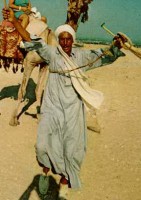
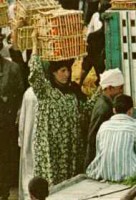 |
|
|
Man in
gallibaya |
Woman in
sebleh |
|
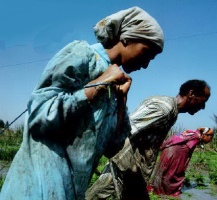 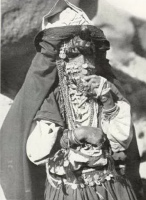 |
|
|
Fellahin - front with hatta (1997) |
Bedouin -
Sinai (1937) |
|
Egyptian Women Wears |
|
|
Peasant women would wear a gallebaya outdoors but in the city gallibaya
tended to be worn only indoors. For public wear a woman would wear a
wide woman's dress called a tob sebleh.
Wide trousers were worn as underclothing (tshalvar or shintijan)
gathered below knee and falling to ankles.
The woman's kaftan was called a yelek. This was lined, with the neck
open to breast and buttoned or laced along side seams for shaping. It
had high side slit over trousers. Girded with shawl. Women would wear a
shirt under the yelek, and a djubbeh or binnish over it.
In Alexandria and Cairo, women would also wear
the
melaya luf - a large rectangular wrap worn for modesty, warmth, and
used to carry things.
City women often worn a bur`a - a long rectangular face veil either
of white cotton or open weave - and a headscarf (sometimes over a
skullcap - taqiyah). Another headcovering was the mandil (headscarf)
sometimes decorated with pom poms. Among the fellahin a bag like hattah
was sometimes worn.
|
|
.jpg) 
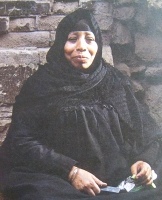

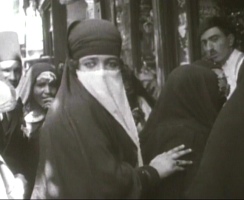
Almehs, Cairo (c1870)
Milaya lef
Fellah (1997)
Fruit seller (c1980)
woman in bur`a (c1920)
|
|
|
Egyptian Men Wears |
|
|
The basic traditional Egyptian garment for men is a long shirt
(gallibaya).
Tilke
also distinguishes one with a looser fit under the arms (eri) and
very wide version of the gallibaya called a kamis which was worn by
fellahin. While working fellahin would hitch up the skirt of the
gallebaya and wrap it around their thighs.
Trousers (sserual) were sometimes worn under the gallebaya.
Over the gallebaya a kaftan (often striped) was worn. A kaftan is a
full length garment like a coat with long wide sleeves open in front and
often bound by a fabric belt (hizan). Over the kaftan was a binish - a
cloth overcoat with wide sleeves - often slit below usually dark grey
and unlined. Alternatively, a djubbeh which had was more complex cut
than the binish could be worn especially by Turks during the Ottoman
occupation. The `ulama also wore a jubbah over stripped kaftan. The
jubbah was a long, wide sleeved gown which reached to feet and was
buttoned half way down.
Tarbushes, shishas (1926)
However, from the 1800s European dress replaced traditional dress among
the Ottoman court and this was taken up by members of the elite.
Therefore, senior civil servants and members of the ruling
intelligentsia could be seen in Egypt in European style clothing.
However European headwear was not adopted. Instead Sultan Mahmud Khan
II decreed that checheya heargear would be worn. In Egypt this was
called "tarboosh". Later Mohammed Ali was to incorporate the tarboosh as
part of the military uniform. This was abolished as headwear after the
1952 revolution. For further information on the layers worn see
Male
Headewear
What was not worn by Egyptians was the Arab kufeya and `igal -
except possibly among some Bedouin.
|
|
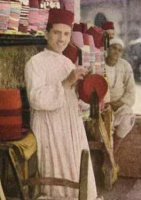 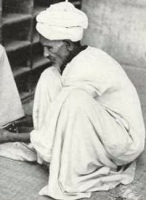 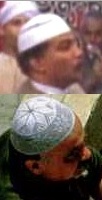
Tarbush maker (1926) -
Cairo 1938 -
Skullcaps |
|
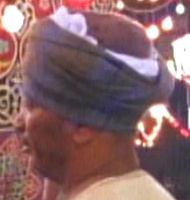
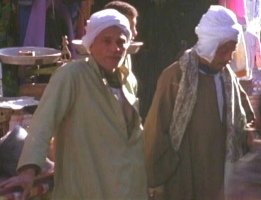
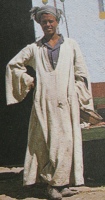
Turban wound over tarbush -
Urban men in market -
Gallibaya (c1980) |
|
| |
|
Nubian Traditional Wears |
|
|
Nubia straddles the south of Egypt and the North of the Sudan. After the
building of the Aswan dam many Nubians were relocated in Aswan. Nubians
belong to five main tribes - two of which (Kanuz and Fadija) are in
Egypt. The Kanuz people are the northernmost.
The Kanuz women wear dresses formed by horizontal lengths of fabric
each of which is longer than the one above giving a dress with almost a
flounce at the bottom. For special occasions - such as weddings a
semi-transparent layer is added over the dress. Fadija women wear a
wrapped garment a little like a sari.
Men wear trousers, shirts, vests and turbans.
|
|
  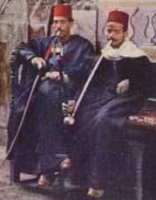
Nubian man 1967
Nubian woman 1966 |
|
| |